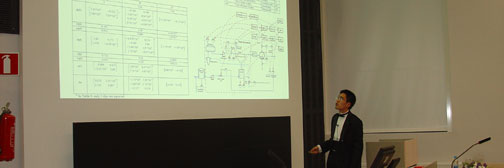| | Year 2002
Tommi HevonojaDevelopment and start-up of ultrafiltration process control system in a publishing paper mill
Closing of water systems has been an important issue in the paper industry for quite a long time. Simultaneously, quality demands for process waters are increasing. This had led to the point when it is necessary to develop new, more efficient water purification methods. One of these methods is ultrafiltration. In theory, ultrafiltration is very efficient water purification method, but in the paper industry, demands for nearly full-automatic systems like CR-ultrafiltration are very high. These arguments led to investments especially in the process control system to be reliable regardless of possible changes in process dynamics.
The theory part of this Master’s thesis includes an introduction to different kinds of membrane filtration methods and comparison of processes and process control differences. The theory part also considers ultrafiltration modeling and process start-up in literature.
The experimental part includes a description of the development of the Kirkniemi PM1 gasket water ultrafiltration system during process- and automation system planning, system testing, process startup and follow-up. Kirkniemi PM1’‘s ultrafiltration system includes three CR1010/100 ultrafilters produced by Metso Raisio. PM1’‘s system is the first of its kind in the world, which gave a good opportunity to design new process control methods. As well as tuning of control circuits; turbidity- and conductivity measuring problems and solutions are presented. Process optimization possibilities are considered in the last part of the work.
The basic structure of the control system was based on experiences with earlier CR-ultrafiltration systems. During system planning and development, many points needed functional changes and extra testing to become reliable. For example, time delays in sequences, functional orders, and rapidity of control circles were discerned to be such points. Reliability of sequences in the strongly dynamic ultrafiltration process was under special consideration. For this reason adaptive process control methods were developed for the system. As a result of process start-up and follow-up the conclusion was that it is possible to make automation of the ultrafiltration process reliable if enough is invested in system planning and start-up tests. Simultaneously, the limited scope of automation to fix mechanical process problems was found.
Practical experiments were carried out on the functioning of turbidity measuring in the short- and long-term. Air bubbles produced in the ultrafiltration process were found to be one of the major problems in turbidity measuring. During this thesis, an adequate solution was designed, but concurrently both the real timing of measuring and independent measure for each filter was forfeited. In the longer follow-up period sliming of the measuring sensor became the main reliability problem. As a result of the examination turbidity measuring as a fault detector of ultrafiltration system was found to be questionable.
Deprecated: strlen(): Passing null to parameter #1 ($string) of type string is deprecated in C:\WWWroot\Root\incs\5_theses\theses_new2010.php on line 248
This info last modified 27 Apr 2024 - contact webmaster
|

